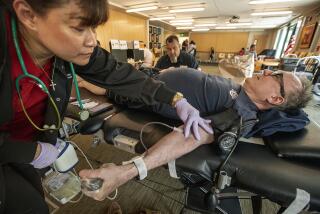AIDS Risk From Transfusion Is Greater Than Once Believed
- Share via
The risk of becoming infected with the AIDS virus through a blood transfusion is significantly higher than previously thought, according to a new study stating that as many as 460 people a year may receive blood contaminated with the virus.
The researchers found that donors unknowingly infected with the fatal virus had ignored precautions and gone ahead and given blood, and that tests designed to screen out tainted blood had then failed to detect the presence of the virus.
For that reason, the researchers urge blood banks to find better ways of discouraging so-called high-risk individuals from giving blood, and they call for prompt evaluation of new screening tests better able to recognize the presence of the virus.
“We can . . . do a better job of keeping infected persons from donating blood,” said Dr. John Ward, a co-author of the article published today in the New England Journal of Medicine. “By getting the message to them . . . , ‘If you are at risk, don’t donate, because you may transmit.’ ”
In response to the article, a national organization that sets standards for blood banks announced Wednesday that it would begin studying new, experimental methods of screening blood to see whether they might be effective if implemented nationwide.
Risk Remains Small
But blood bank officials as well as the researchers emphasized that the risk of infection by transfusion remains small. Some 7,000 new transfusion-related infections--far more than the 460 estimated--occurred in the year before current screening began in 1985.
“We need to keep the risk in perspective,” said Jackie Campbell, a spokesman for the American Assn. of Blood Banks. “Our point is that the risk from not getting a transfusion that you need is greater than the risk of getting one.”
In addition, a spokesman for the federal Food and Drug Administration, which regulates blood banks, pointed out that new precautions have been added since the cases covered in the study. He said those steps make the risk even more remote today.
For example, literature given to all donors more clearly explains who might be at risk for infection and therefore should not donate blood. Donors are also now given the option of specifying that their blood be used for research and not for transfusions.
Some 4 million people a year receive transfusions of whole blood, platelets and other blood products. Since March 1985, all such blood has been screened using two tests that detect antibodies to the virus--a sign that the person has been exposed.
But studies indicate that antibodies may be undetectable by current tests until six to 14 weeks after a person is infected. If he or she is infected shortly before donating, the tests may not identify the presence of the virus.
In the past, federal authorities have said the blood supply is virtually safe and that the chances of AIDS infection are minimal. Some researchers had estimated that 72 to 90 people might be infected each year by blood that screened negative for the virus.
In an attempt to identify how such cases were occurring, researchers with the federal Centers for Disease Control investigated the cases of 13 people who became infected by blood donated by seven persons who had screened negative for AIDS antibodies.
Peer Pressure
The study found that six of the seven donors had identifiable risk factors and should not have given blood. They went ahead anyway for reasons ranging from peer pressure to one man’s desire to find out whether he was infected.
One donor told the researchers he had been turned away earlier from a plasma collection center and had had numerous anonymous sexual partners 12 to 16 weeks before donation. Others told the researchers that they had had homosexual and bisexual contacts. One did not perceive himself to be at risk.
The researchers concluded that in most of the cases the presence of the virus went undetected because the donors had become infected shortly before donation. None of the people were long-time donors who had repeatedly given blood, the researchers said.
“I think our paper tries to point out that there is still a risk of transmission of the virus by transfusion,” Ward said in a telephone interview this week. “But that risk is a very, very small one.”
Responding to Ward’s findings, Campbell said the blood bank association also intends to consider more rigorous quizzing of donors to determine risk. In addition to receiving written information, all donors might have to discuss the subject of risk with bank workers.
Discussed With Donors
Ralph Wright, a spokesman for the Los Angeles Chapter of the American Red Cross, said Red Cross workers already discuss such things with all donors. “We are extremely careful on screening out donors to make sure we have as safe a blood supply as possible,” he said.






